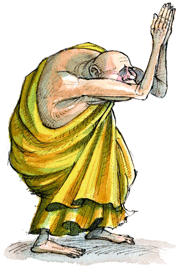
|
|
|
Home Asia Pacific South East Asia Myanmar Myanmar Protest News The Burmese Way to Fascismby Bertil Lintner , Far Eastern Economic Review, October 2007Bangkok, Thailand -- If Karl Marx was right that history repeats itself first as tragedy and then as farce, Burma is still stuck in the tragedy phase. The protests and crackdown in Rangoon in recent days are reprising the doomed democracy movement of 1988. As time passes and the security forces succeed in cowing the population, the world’s outrage gives way to ineffectual responses and then resignation.
In the initial euphoria that such mass movements inevitably bring, the Western media dubbed this Burma’s saffron revolution, comparing it to the peaceful “color revolutions” of Eastern Europe and the former Soviet Union. So named because of the leading role played by Buddhist monks, the movement seemed destined to sweep away the unpopular military regime that has impoverished a country once among the wealthiest in Asia. The moral authority of the clergy, combined with the flow of information to the outside world facilitated by new technology, stoked the sense of optimism. The U.S. imposed tougher sanctions, while even China and the Association of South-East Asian Nations, not normally known for putting pressure on their neighbors, issued strong statements. However, the reality is that nothing substantive has changed since 1988. In fact, the Burmese regime is arguably stronger than it has ever been. It is well prepared to weather this new storm of domestic and international criticism.
When the army first seized power in Burma in 1962, it not only took control over the government, but also assumed economic power. Branded the “Burmese Way to Socialism,” this meant that almost all private property was confiscated and handed over to a number of military-run state corporations. The old mercantile elite, which to a large extent was of ethnic Indian and Chinese origin, left the country, and so did many of Burma’s intellectuals. Prior to the 1962 coup, Burma had had one of the highest living standards in Southeast Asia, and a fairly well-educated population. But thereafter the military became the only elite. The Burmese military establishment also developed into a state-within-a-state, a society where army personnel, their families and dependents enjoy a position far more privileged than their counterparts ever had in, for instance, Thailand and Indonesia. In both those countries, some degree of pluralism was always accepted even during the darkest years of military dictatorship. After the last uprising in 1988, the Burmese Way to Socialism was abolished after the 1988 uprising, perhaps in an attempt to appease the international community, which had condemned the carnage in Rangoon, but also because the military had realized that they could make more money in a free-market economy. Private enterprise and foreign investment were permitted after the bloody events of 1988, when at least 3,000 protesters were gunned down, but, in essence, the Burmese Way to Capitalism is also a military-dominated economy. There are few major enterprises which are not directly or indirectly controlled by the military, or by businessmen affiliated with the military, like the powerful, 43-year-old tycoon Tay Za, who is close to junta leader Gen. Than Shwe and his family. His Htoo Trading Company was one of two main contractors that built Burma’s new administrative capital, Naypyidaw. The other was the Asia World Group, which is headed by Tun Myint Naing, or Steven Law, the son of Lo Hsing-han, who in the 1970s was branded by U.S. authorities as the king of opium in Burma’s sector of the Golden Triangle. In Burma, there are special schools and hospitals for the military and their dependents. They live in secluded, subsidized housing and shop for goods that are not available in ordinary stores. An army pass assures the holder of a seat on a train or an airplane, and a policeman would never dare to report him or her for violating traffic rules. The military’s only civilian support base is the Union Solidarity and Development Association, USDA, which was formed in 1992. It claims to have 21 million members, but that is mainly because membership is compulsory for civil servants and ordinary citizens are forced to join. Like the Burma Socialist Program Party, BSPP, which ruled Burma until the 1988 uprising, it is a colossus on feet of clay, which, in the wake of current events, is likely to collapse, as the BSPP did 19 years ago. The rise of military power in Burma began shortly after independence from Britain on Jan. 4, 1948. Communist as well as ethnic rebel armies rose in rebellion against Rangoon, and, in the northeast, remnants of Chiang Kai-shek’s Nationalist Chinese forces retreated across the border after being defeated by Mao Zedong’s communists. At independence, the Burmese army was only 15,000 strong, plus militias. But by 1955, because of the civil war, the ranks of the army had increased to 40,000, and it was already involved in businesses such as shipping, banking and publishing. When the emerging state-within-a-state gobbled up the state in 1962, there were 104,200 men in all three services. That rose to 140,000 in 1976, 160,000 in 1985, and, at the time of the 1988 uprising, 180,000 in the army and nearly 200,000 in all three services. Today, the strength of the three services is estimated at 400,000, and they are much better equipped than at any time in Burma’s modern history, mainly due to massive procurement of arms from China. The latest expansion comes at a time when the ruling military has managed to strike cease-fire agreements with most of the country’s rebel groups, so, during the past decade, there has been very little fighting in Burma’s traditionally volatile frontier areas. The enemy now is the population at large. China’s support is a key factor in the junta’s staying power, and Beijing wants “stability,” not a regime change. In January this year, China—along with Russia—used its veto power to block a U.S. and U.K.- sponsored resolution in the U.N. Security Council, although a majority of U.N. members had voted in favor. The Chinese insisted that the Burmese regime did not a pose a threat to regional security and, therefore, the Security Council was not the right forum to pass resolutions on political repression in Burma. Not even appeals by activists for a boycott of the 2008 Beijing Olympics seem to have swayed China into being more critical of the Burmese regime. China has not reacted to pictures from the carnage in Rangoon showing Burmese soldiers carrying Chinese-made T-56 automatic assault rifles. It may be argued that Chinese military aid is of little help in quelling urban unrest. But the modernization of Burma’s armed forces since 1988 has also served the purpose of ensuring the loyalty of the military, which is crucial for the survival of the present regime. Nothing is going to change as long as the military remains united, and there have so far been no credible reports of splits within the military. Given the abuse of power, their privileges and the atrocities they have committed, the Burmese military has everything to lose and nothing to gain from allowing more openness and transparency. Foreign-based opposition groups like to talk about “dialogue” and “national reconciliation,” but these are no more than popular buzzwords with little relevance inside Burma, where the military talks to no one but itself. A Rangoon-based Western diplomat once put it to me quite bluntly: “They fear that if they don’t hang together, they’ll hang separately.” The junta is now reading from its standard playbook, blaming the “disturbances” on “internal and external destructionists.” In a speech on Sept. 24, Burma’s religious affairs minister, Brig.-Gen. Thura Myint Maung, asserted that “political extremists” from the pro-democracy National League for Democracy, NLD, “remnants” of the Communist Party of Burma (which has been defunct for more than 18 years), and foreign broadcasting stations had instigated Buddhist monks and others to demonstrate. The situation, he said, was being handled “softly” and “with care.” Meanwhile, the National League for Democracy, formed shortly after the 1988 uprising, has been decimated. Its main leader, Aung San Suu Kyi, has charisma but she remains under house arrest, and nearly the entire, original leadership of the NLD is either dead, in prison or has simply given up all political activity. Most young NLD activists have been imprisoned, cowed into submission, or have fled the country. Only a handful of elderly spokespersons remain, and none of them has the strength and charisma to carry the party forward. That serves the interests of the junta, since the new-look NLD would appear to the outside world not to be a viable alternative. Nor have external forces had much influence over Burma’s ruling generals. Western sanctions have had minimal effect, as the country’s neighbors—China, India and Asean—continue to trade and invest in the country, allowing the generals to use their ample natural resources and strategic geographical position to survive. China was the first major country to show interest in Burma’s riches, even before the events of 1988. Pan Qi, former vice minister of communications, wrote an article in the Sept. 2, 1985 Beijing Review entitled “Opening to the Southwest: An Expert Opinion,” outlining the possibility of finding an outlet through Burma to the Indian Ocean for trade from China’s landlocked provinces of Yunnan and Sichuan. He mentioned the Burmese railheads of Myitkyina and Lashio in the northeast, and the Irrawaddy River, as possible conduits for the export of Chinese goods. By late 1991, Chinese experts were assisting in a series of infrastructure projects to spruce up the poorly maintained roads and railways. Chinese military advisers also arrived in the same year, the first foreign military personnel to be stationed in Burma since the Australians had a contingent there to train the Burmese army in the 1950s. The total value of Chinese arms deliveries to Burma is not known, but intelligence sources estimate it to be about $1.4 billion. Burma’s close relationship with China caused concern in India. To counter China’s growing influence, at first India supported Burma’s pro-democracy movement. But when it became clear that it was not going to come to power within the foreseeable future, India began to court the junta. Enticing Burma to distance itself from China, however, was not New Delhi’s only concern; the rapidly expanding Indian economy needs energy, and Burma has ample resources of natural gas. During the current turmoil, China blocked an attempt by the U.N. Security Council to adopt a binding resolution of Burma, while a spokesman for the Indian government on Sept. 26 made a rather bland statement: “The government of India is concerned at and is closely monitoring the situation in Myanmar (Burma). It is our hope that all sides will resolve their issues peacefully through dialogue. India has always believed that Myanmar’s process of political reform and national reconciliation should be more inclusive and broad-based.” Burma’s generals are, therefore, firmly entrenched in power, and not overly worried about condemnation by the West. That doesn’t mean that their position is entirely secure. They remain profoundly despised by the population at large and, last year, an entirely new movement began to take shape. It consisted of veterans of the 1988 uprising, the most prominent among them being Min Ko Naing, a student leader who was arrested in March 1989—and released only in November 2005, after nearly 16 years in solitary confinement. In 1988 he was a 26-year-old zoology student addressing crowds of tens of thousands in Rangoon. When he was released he was 42, and his years in prison had left their mark on his face and body. In 2005, he looked old and haggard—but his fighting spirit had not been quelled. “The people of Burma must have the courage to say ‘no’ to injustice and ‘yes’ to truth,” he said at a meeting of the newly formed “88-Generation Students’ Group” in Rangoon in August 2006. Min Ko Naing’s group played an important role in organizing the first protests in August, shortly after the authorities had increased the price of petrol and fuel, causing further hardships for a population that was already suffering from rising living costs. But the entire leadership of the group was arrested immediately, depriving the movement of direction. The monks, who took the initiative in the street marches which led to a renewed mass movement, can only mobilize people and take the moral high ground; as monks, they cannot be political leaders. Thus, unlike in 1988 when a number of political leaders emerged, among them Aung San Suu Kyi, the current movement is leaderless and rudderless. The bitter reality is that nothing is going to change as long as the military remains united and willing to gun down its own people. A younger generation of army officers, who see the need to negotiate with the pro-democracy movement, is probably the only hope. But for now, no one is aware of any “young Turks” lurking in the wings, and there are no signs of serious cracks within the ranks. But if change does come to Burma, it will in any event be because of action taken by such younger army officers, not demonstrations led by monks. The protests can, at the most, influence sections of the army to realize that there is no future in supporting the present regime. But only time will tell if that is going to happen. |
 Get your Korean Buddhist News here, brought to you by BTN-Buddhist Channel |
 |
 The Mandala app brings together Buddhist wisdom and meditation techniques with the latest insights of psychology and neuroscience to handle the challenges and complexities of modern life. The App offers a series of engaging talks and conversations with experts on a wide variety of topics, such as managing stress, dealing with adversity, developing greater resilience, cultivating empathy and compassion, creating healthy relationships, and many more. These topics are explored to help find greater peace, meaning and joy in our lives. Our panel of experts include Dr, Thupten Jinpa, Daniel Goleman, Kelly McGonigal and others.FREE DOWNLOAD here |
| Point
your feed reader to this location |
| Submit an Article |
| Write to the Editor |

 << HARRY HARRISON
<< HARRY HARRISON